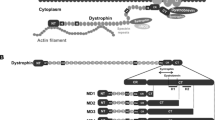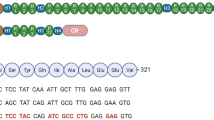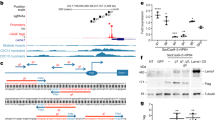Abstract
Myostatin is a negative regulator of muscle mass whose inhibition has been proposed as a therapeutic strategy for muscle-wasting conditions. Indeed, blocking myostatin action through different strategies has proved beneficial for the pathophysiology of the dystrophin-deficient mdx mouse. In this report, we tested the inhibition of myostatin by AAV-mediated expression of a mutated propeptide in animal models of two limb-girdle muscular dystrophies: LGMD2A caused by mutations in the calpain 3 (CAPN3) gene and LGMD2D caused by mutations in the α-sarcoglycan gene (SGCA). In the highly regenerative Sgca-null mice, survival of the α-sarcoglycan-deficient muscle fibers did not improve after transfer of the myostatin propeptide. In calpain 3-deficient mice, a boost in muscle mass and an increase in absolute force were obtained, suggesting that myostatin inhibition could constitute a therapeutic strategy in this predominantly atrophic disorder.
This is a preview of subscription content, access via your institution
Access options
Subscribe to this journal
Receive 12 print issues and online access
$259.00 per year
only $21.58 per issue
Buy this article
- Purchase on Springer Link
- Instant access to full article PDF
Prices may be subject to local taxes which are calculated during checkout




Similar content being viewed by others
References
Grobet L, Martin LJ, Poncelet D, Pirottin D, Brouwers B, Riquet J et al. A deletion in the bovine myostatin gene causes the double-muscled phenotype in cattle. Nat Genet 1997; 17: 71–74.
Kambadur R, Sharma M, Smith TP, Bass JJ . Mutations in myostatin (GDF8) in double-muscled Belgian Blue and Piedmontese cattle. Genome Res 1997; 7: 910–916.
McPherron AC, Lee SJ . Double muscling in cattle due to mutations in the myostatin gene. Proc Natl Acad Sci USA 1997; 94: 12457–12461.
Szabo G, Dallmann G, Muller G, Patthy L, Soller M, Varga L . A deletion in the myostatin gene causes the compact (Cmpt) hypermuscular mutation in mice. Mamm Genome 1998; 9: 671–672.
Schuelke M, Wagner KR, Stolz LE, Hubner C, Riebel T, Komen W et al. Myostatin mutation associated with gross muscle hypertrophy in a child. N Engl J Med 2004; 350: 2682–2688.
Clop A, Marcq F, Takeda H, Pirottin D, Tordoir X, Bibe B et al. A mutation creating a potential illegitimate microRNA target site in the myostatin gene affects muscularity in sheep. Nat Genet 2006; 38: 813–818.
McPherron AC, Lawler AM, Lee SJ . Regulation of skeletal muscle mass in mice by a new TGF-beta superfamily member. Nature 1997; 387: 83–90.
Zhu X, Hadhazy M, Wehling M, Tidball JG, McNally EM . Dominant negative myostatin produces hypertrophy without hyperplasia in muscle. FEBS Lett 2000; 474: 71–75.
Yang J, Ratovitski T, Brady JP, Solomon MB, Wells KD, Wall RJ . Expression of myostatin pro domain results in muscular transgenic mice. Mol Reprod Dev 2001; 60: 351–361.
Nishi M, Yasue A, Nishimatu S, Nohno T, Yamaoka T, Itakura M et al. A missense mutant myostatin causes hyperplasia without hypertrophy in the mouse muscle. Biochem Biophys Res Commun 2002; 293: 247–251.
Grobet L, Pirottin D, Farnir F, Poncelet D, Royo LJ, Brouwers B et al. Modulating skeletal muscle mass by postnatal, muscle-specific inactivation of the myostatin gene. Genesis 2003; 35: 227–238.
Whittemore LA, Song K, Li X, Aghajanian J, Davies M, Girgenrath S et al. Inhibition of myostatin in adult mice increases skeletal muscle mass and strength. Biochem Biophys Res Commun 2003; 300: 965–971.
Walsh FS, Celeste AJ . Myostatin: a modulator of skeletal-muscle stem cells. Biochem Soc Trans 2005; 33: 1513–1517.
Reisz-Porszasz S, Bhasin S, Artaza JN, Shen R, Sinha-Hikim I, Hogue A et al. Lower skeletal muscle mass in male transgenic mice with muscle-specific overexpression of myostatin. Am J Physiol Endocrinol Metab 2003; 285: E876–E888.
Zimmers TA, Davies MV, Koniaris LG, Haynes P, Esquela AF, Tomkinson KN et al. Induction of cachexia in mice by systemically administered myostatin. Science 2002; 296: 1486–1488.
Lee SJ . Regulation of muscle mass by myostatin. Annu Rev Cell Dev Biol 2004; 20: 61–86.
Tobin JF, Celeste AJ . Myostatin, a negative regulator of muscle mass: implications for muscle degenerative diseases. Curr Opin Pharmacol 2005; 5: 328–332.
Hill JJ, Davies MV, Pearson AA, Wang JH, Hewick RM, Wolfman NM et al. The myostatin propeptide and the follistatin-related gene are inhibitory binding proteins of myostatin in normal serum. J Biol Chem 2002; 277: 40735–40741.
Wolfman NM, McPherron AC, Pappano WN, Davies MV, Song K, Tomkinson KN et al. Activation of latent myostatin by the BMP-1/tolloid family of metalloproteinases. Proc Natl Acad Sci USA 2003; 100: 15842–15846.
Rebbapragada A, Benchabane H, Wrana JL, Celeste AJ, Attisano L . Myostatin signals through a transforming growth factor beta-like signaling pathway to block adipogenesis. Mol Cell Biol 2003; 23: 7230–7242.
Zhu X, Topouzis S, Liang LF, Stotish RL . Myostatin signaling through Smad2, Smad3 and Smad4 is regulated by the inhibitory Smad7 by a negative feedback mechanism. Cytokine 2004; 26: 262–272.
Patel K, Amthor H . The function of Myostatin and strategies of myostatin blockade-new hope for therapies aimed at promoting growth of skeletal muscle. Neuromuscul Disord 2005; 15: 117–126.
Roth SM, Walsh S . Myostatin: a therapeutic target for skeletal muscle wasting. Curr Opin Clin Nutr Metab Care 2004; 7: 259–263.
Khurana TS, Davies KE . Pharmacological strategies for muscular dystrophy. Nat Rev Drug Discov 2003; 2: 379–390.
Engvall E, Wewer UM . The new frontier in muscular dystrophy research: booster genes. FASEB J 2003; 17: 1579–1584.
Bogdanovich S, Krag TO, Barton ER, Morris LD, Whittemore LA, Ahima RS et al. Functional improvement of dystrophic muscle by myostatin blockade. Nature 2002; 420: 418–421.
Wagner KR, McPherron AC, Winik N, Lee SJ . Loss of myostatin attenuates severity of muscular dystrophy in mdx mice. Ann Neurol 2002; 52: 832–836.
Bogdanovich S, Perkins KJ, Krag TO, Whittemore LA, Khurana TS . Myostatin propeptide-mediated amelioration of dystrophic pathophysiology. FASEB J 2005; 19: 543–549.
Holmes JH, Ashmore CR, Robinson DW . Effects of stress on cattle with hereditary muscular hypertrophy. J Anim Sci 1973; 36: 684–694.
McMahon CD, Popovic L, Oldham JM, Jeanplong F, Smith HK, Kambadur R et al. Myostatin-deficient mice lose more skeletal muscle mass than wild-type controls during hindlimb suspension. Am J Physiol Endocrinol Metab 2003; 285: E82–E87.
Li ZF, Shelton GD, Engvall E . Elimination of myostatin does not combat muscular dystrophy in dy mice but increases postnatal lethality. Am J Pathol 2005; 166: 491–497.
Duguez S, Bartoli M, Richard I . Calpain 3: a key regulator of the sarcomere? FEBS J 2006; 273: 3427–3436.
Roberds SL, Leturcq F, Allamand V, Piccolo F, Jeanpierre M, Anderson RD et al. Missense mutations in the adhalin gene linked to autosomal recessive muscular dystrophy. Cell 1994; 78: 625–633.
Ozawa E, Mizuno Y, Hagiwara Y, Sasaoka T, Yoshida M . Molecular and cell biology of the sarcoglycan complex. Muscle Nerve 2005; 32: 563–576.
Lim LE, Campbell KP . The sarcoglycan complex in limb-girdle muscular dystrophy. Curr Opin Neurol 1998; 11: 443–452.
Kramerova I, Kudryashova E, Tidball JG, Spencer MJ . Null mutation of calpain 3 (p94) in mice causes abnormal sarcomere formation in vivo and in vitro. Hum Mol Genet 2004; 13: 1373–1388.
Fougerousse F, Gonin P, Durand M, Richard I, Raymackers JM . Force impairment in calpain 3-deficient mice is not correlated with mechanical disruption. Muscle Nerve 2003; 27: 616–623.
Bartoli M, Poupiot J, Goyenvalle A, Perez N, Garcia L, Danos O et al. Noninvasive monitoring of therapeutic gene transfer in animal models of muscular dystrophies. Gene Therapy 2006; 13: 20–28.
Bartoli M, Roudaut C, Martin S, Fougerousse F, Suel L, Poupiot J et al. Safety and efficacy of AAV-mediated calpain 3 gene transfer in a mouse model of limb-girdle muscular dystrophy type 2A. Mol Ther 2006; 13: 250–259.
Kramerova I, Kudryashova E, Venkatraman G, Spencer MJ . Calpain 3 participates in sarcomere remodeling by acting upstream of the ubiquitin-proteasome pathway. Hum Mol Genet 2005; 14: 2125–2134.
Wang M, Orsini C, Casanova D, Millan JL, Mahfoudi A, Thuillier V . MUSEAP, a novel reporter gene for the study of long-term gene expression in immunocompetent mice. Gene 2001; 279: 99–108.
Snyder RO, Miao CH, Patijn GA, Spratt SK, Danos O, Nagy D et al. Persistent and therapeutic concentrations of human factor IX in mice after hepatic gene transfer of recombinant AAV vectors. Nat Genet 1997; 16: 270–276.
Apparailly F, Khoury M, Vervoordeldonk MJ, Adriaansen J, Gicquel E, Perez N et al. Adeno-associated virus pseudotype 5 vector improves gene transfer in arthritic joints. Hum Gene Ther 2005; 16: 426–434.
Zhang HG, Wang YM, Xie JF, Liang X, Hsu HC, Zhang X et al. Recombinant adenovirus expressing adeno-associated virus cap and rep proteins supports production of high-titer recombinant adeno-associated virus. Gene Therapy 2001; 8: 704–712.
Fougerousse F, Bartoli M, Poupiot J, Arandel L, Durand M, Guerchet N et al. Phenotypic correction of α-sarcoglycan deficiency by intra-arterial injection of a muscle-specific serotype 1 rAAV vector. Mol Ther 2007; 15: 53–61.
Duclos F, Straub V, Moore SA, Venzke DP, Hrstka RF, Crosbie RH et al. Progressive muscular dystrophy in alpha-sarcoglycan-deficient mice. J Cell Biol 1998; 142: 1461–1471.
Richard I, Broux O, Allamand V, Fougerousse F, Chiannilkulchai N, Bourg N et al. Mutations in the proteolytic enzyme calpain 3 cause limb-girdle muscular dystrophy type 2A. Cell 1995; 81: 27–40.
Gonin P, Arandel L, Van Wittenberghe L, Marais T, Perez N, Danos O . Femoral intra-arterial injection: a tool to deliver and assess recombinant AAV constructs in rodents whole hind limb. J Gene Med 2005; 7: 782–791.
Acknowledgements
We thank the production and the in vivo departments of Généthon, especially Muriel Durand and Nicolas Guerchet. We also thank the Howard Hughes Medical Institute (Iowa City, IA, USA) for providing us with Sgca-null mice. We thank Elisabeth Baudoin for manuscript editing. This work was funded by the Association Française contre les Myopathies, the Centre National de la Recherche Scientifique, Genopole (Evry) and the Fondation pour la Recherche Médicale.
Author information
Authors and Affiliations
Corresponding author
Rights and permissions
About this article
Cite this article
Bartoli, M., Poupiot, J., Vulin, A. et al. AAV-mediated delivery of a mutated myostatin propeptide ameliorates calpain 3 but not α-sarcoglycan deficiency. Gene Ther 14, 733–740 (2007). https://doi.org/10.1038/sj.gt.3302928
Received:
Revised:
Accepted:
Published:
Issue Date:
DOI: https://doi.org/10.1038/sj.gt.3302928
Keywords
This article is cited by
-
Adeno-associated virus-mediated expression of myostatin propeptide improves the growth of skeletal muscle and attenuates hyperglycemia in db/db mice
Gene Therapy (2017)
-
Downregulation of myostatin pathway in neuromuscular diseases may explain challenges of anti-myostatin therapeutic approaches
Nature Communications (2017)
-
Calpain research for drug discovery: challenges and potential
Nature Reviews Drug Discovery (2016)
-
Prospect for Pharmacological Therapies to Treat Skeletal Muscle Dysfunction
Calcified Tissue International (2015)
-
Ongoing Developments in Sporadic Inclusion Body Myositis
Current Rheumatology Reports (2014)



